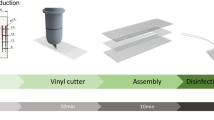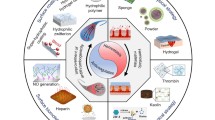Abstract
In order to effectively pump liquid in a fluidic chip, the PDMS or SU8 channels were frequently modified by surface treatments to obtain the hydrophilic surface but encountered the problem of the hydrophobic recovery. In this article, long-term highly hydrophilic fluidic chips were demonstrated using rapid fabrication of low-power CO2 laser ablation and low-temperature glass bonding with an interlayer of liquid crystal polymer (LCP). The intrinsic hydrophilic materials of glass and LCP were beneficial for self-driven flow in the long-term fluidic chip by surface-tension force with no extra fluidic pumps. The higher viscosity fluid could increase the difficulty of self-driven capability. The stability of contact angle and flow test of the chip after 2 months is similar to that at beginning. The high-viscosity human whole blood was successfully driven at an average moving velocity of about 1.89 mm/s for the beginning and at 2.04 mm/s after 2 months. Our fluidic chip simplifies the traditional complex fabrication procedure of glass chips and conquers the problem of traditional hydrophobic recovery.






Similar content being viewed by others

References
Chung CK, Sung YC, Huang GR, Hsiao EJ, Lin WH, Lin SL (2008) Crackless linear through-wafer etching of pyrex glass using liquid-assisted CO2 laser processing, Appl Phys A (in press). doi:10.1007/s00339-008-4863-x
Daridon A, Fascio V, Lichtenberg J, Wütrich R, Langen H, Verpoorte E, de Rooij NF (2001) Multi-layer microfluidic glass chips for microanalytical applications. Fresenius J Anal Chem 371:261–269
Eddington DT, Puccinelli JP, Beebe DJ (2006) Thermal aging and reduced hydrophobic recovery of polydimethylsiloxane. Sens Actuators B 114:170–172
Efimenko K, Wallace WE, Genzer J (2002) Surface modification of Sylgard-184 (dimethyl siloxane) networks by ultraviolet and ultraviolet/ozone treatment. J Colloid Interface Sci 254:306–315
Gravesen P, Branebjerg J, Jensen O (1993) Microfluidics—a review. J Micromech Microeng 3:168–182
Hillborg H, Gedde UW (1998) Hydrophobicity. Recovery of polydimethylsiloxane. Polymer 39:1991–1998
Jong WR, Kuo TH, Ho SW, Chiu HH, Peng SH (2007) Flows in rectangular microchannels driven by capillary force and gravity. Int Commun Heat Mass Transf 34:186–196
Kim DS, Lee SH, Ahn CH, Lee JY, Kwon TH (2006) Disposable integrated microfluidic biochip for blood typing by plastic microinjection moulding. Lab Chip 6:794–802
Makamba H, Kim JH, Lim K, Park N, Hahn JH (2003) Surface modification of poly(dimethylsiloxane) microchannels. Electrophoresis 24:3607–3619
Prakash R, Kaler KVIS (2007) An integrated genetic analysis microfluidic platform with valves and a PCR chip reusability method to avoid contamination. Microfluidics Nanofluidics 3:177–187
Vickers JA, Caulum MM, Henry CS (2006) Generation of hydrophilic poly(dimethylsiloxane) for high-performance microchip electrophoresis. Anal Chem 78:7446–7452
Walther F, Davydovskaya P, Zürcher S, Kaiser M, Herberg H, Gigler AM, Stark RW (2007) Stability of the hydrophilic behavior of oxygen plasma activated SU-8. J Micromech Microeng 17:524–531
Wang X, Engel J, Liu C (2003) Liquid crystal polymer (LCP) for MEMS: processes and applications. J Micromech Microeng 13:628–633
Yuen PK, Kricka LJ, Fortina P, Panaro NJ, Sakazume T, Wilding P (2001) Microchip module for blood sample preparation and nucleic acid amplification reactions. Genome Res 11:405–412
Acknowledgments
This work is partial sponsored by National Science Council (NSC) under contract No 95-2221-E-006-047-MY3 and 96-2628-E-006-080-MY3. We also pay our sincere thanks to Center for Micro/Nano Science and Technology at National Cheng Kung University for the support of equipments.
Author information
Authors and Affiliations
Corresponding author
Rights and permissions
About this article
Cite this article
Chung, C.K., Chen, Y.S. & Shih, T.R. Fabrication and flow test of long-term hydrophilic fluidic chip without using any surface modification treatment. Microfluid Nanofluid 6, 853–857 (2009). https://doi.org/10.1007/s10404-008-0363-8
Received:
Accepted:
Published:
Issue Date:
DOI: https://doi.org/10.1007/s10404-008-0363-8



